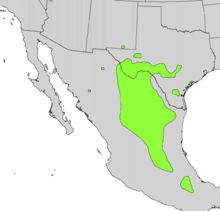Dermatophyllum secundiflorum
| Dermatophyllum secundiflorum | |
|---|---|
 |
|
| Dermatophyllum secundiflorum flowers and leaves | |
| Scientific classification | |
| Kingdom: | Plantae |
| (unranked): | Angiosperms |
| (unranked): | Eudicots |
| (unranked): | Rosids |
| Order: | Fabales |
| Family: | Fabaceae |
| Genus: | Dermatophyllum |
| Species: | D. secundiflorum |
| Binomial name | |
|
Dermatophyllum secundiflorum (Ortega) Gandhi & Reveal |
|
 |
|
| Natural range | |
| Synonyms | |
|
|
Dermatophyllum secundiflorum is a species of flowering shrub or small tree in the pea family, Fabaceae, that is native to the southwestern United States (Texas, New Mexico) and Mexico (Chihuahua and Coahuila south to Hidalgo, Puebla and Querétaro). Common names include Texas mountain laurel, Texas mescalbean, frijolito, and frijolillo. Although "mescalbean" is among the plant's common appellations, it bears no relation to the Agave species used to make the spirit mezcal, nor to the peyote cactus (Lophophora williamsii), which contains the hallucinogenic alkaloid mescaline.
It is well-adapted to arid and semi-arid habitats but is most common in riparian zones.
An evergreen, its leaves are pinnately compound, with small, roughly spatulate leaflets; the leaflets are rather thick, and waxy to the touch. Never tall, and rarely having a straight trunk, its bark is smooth in all but the oldest specimens. It grows slowly to a height of 15 ft (4.6 m) and a crown diameter of 10 ft (3.0 m).
Extremely fragrant purple flowers, resembling the smell of grape soda, are produced in large clusters in March and April. They are followed by 4 in (10 cm) pods containing deep orange seeds.
...
Wikipedia
